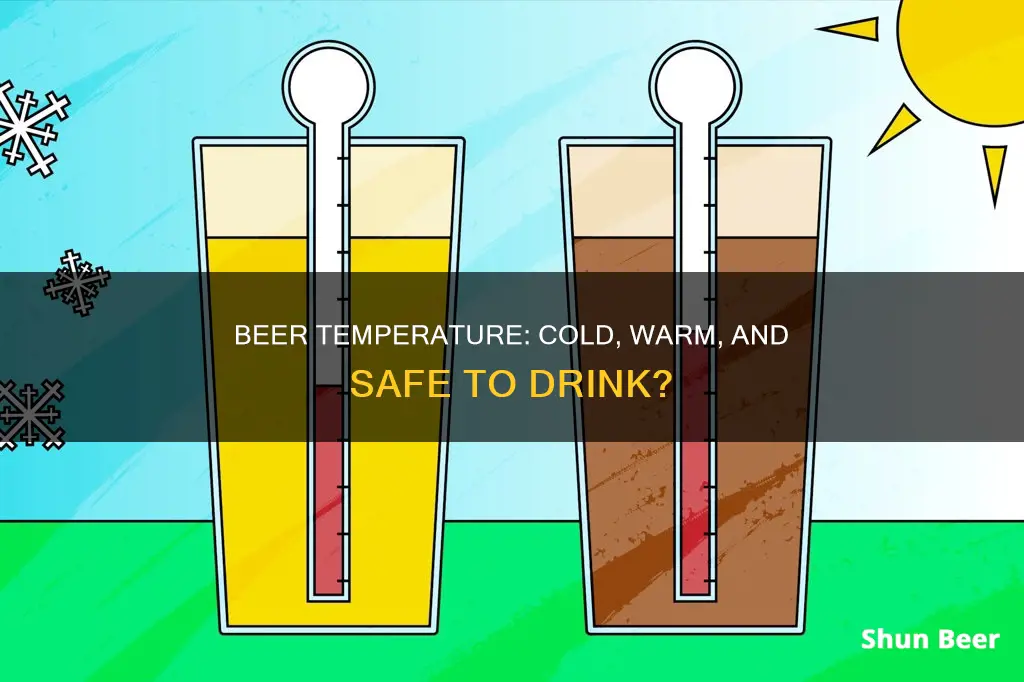
It is a common misconception that beer that has been chilled and then allowed to warm up is unsafe to drink. This is a myth. Beer can be warmed and cooled again without any ill effects. In fact, beer likely goes through several cold-warm cycles on its journey from the brewery to the consumer. Extreme temperature fluctuations, such as from 100°F to below freezing, should be avoided, as this may affect the beer's flavor and cause it to explode. However, as long as the beer is not exposed to extreme temperatures for prolonged periods, it is safe to drink and will not make you sick.
| Characteristics | Values |
|---|---|
| Can you drink beer that has been cold then warm? | Yes, it is a myth that temperature cycling "skunks" beer. |
| What causes "skunky" beer? | Light is the number one cause of "skunky" beer, not temperature. |
| How does temperature affect beer? | Beer is best preserved when kept cold. Keeping beer at room temperature can drop its shelf life from nearly six months to only a few weeks, and exposing the same beer to very warm temperatures can affect its flavor in a matter of a couple of days. |
What You'll Learn

Beer can be warmed and cooled again without spoiling
The myth that beer cannot be warmed and cooled again without spoiling is likely to have originated from the observation that beer left out at room temperature for extended periods can develop a stale taste. However, this is due to exposure to warm temperatures, not temperature cycling. Keeping beer refrigerated will help to preserve its flavour, just as milk lasts longer when refrigerated.
It is worth noting that temperature does affect beer. Beer left in a hot car, for example, may start to taste stale, even if it is not exposed to sunlight. However, this is due to the extreme temperature rather than temperature cycling.
In summary, beer can be warmed and cooled again without spoiling. While it is best to keep beer refrigerated to preserve its flavour, minor temperature changes will not affect its quality.
Drinking Beer in Marrakech: What's the Deal?
You may want to see also

Extreme temperature fluctuations can affect beer
Repeatedly cooling and warming beer can induce a permanent haze, where proteins and tannins bond to create semi-soluble molecules. However, this has no impact on flavour, aroma or mouthfeel. It is mostly an issue in home-brewed beers.
It is important to note that light is the number one cause of "skunky" beer, not temperature. If beer is exposed to light, it can develop a skunky flavour, but temperature cycling alone will not cause this.
While it is best to store beer cold to maintain its freshness and flavour, it is safe to drink beer that has been through a few cycles of cooling and warming.
Beer and Fluconazole: Is It Safe to Mix?
You may want to see also

Light is the main cause of skunky beer
It is a myth that beer spoils if it goes from cold to warm and back to cold again. Beer is best preserved when kept cold, and it is true that keeping beer at room temperature can reduce its shelf life. However, temperature cycling has little to no effect on beer freshness. Beer likely undergoes several cycles of cooling and warming on its journey from the brewery to your glass, and it is still drinkable.
Now, onto the main topic: light is the primary cause of skunky beer.
Skunked beer, or "lightstruck" beer, is bottled beer that undergoes a chemical reaction when exposed to ultraviolet or artificial light. Hops, one of the main ingredients used in making beer, contain alpha acids, which are very sensitive to light. When these acids break down, they react with the sulfur content in the beer. This produces a compound known as 3-methyl-2-butene-1-thiol (MBT), which smells strikingly similar to a skunk's secretion.
The human taste buds are very perceptive to sulfur compounds, so it doesn't take a lot of sunlight to ruin a beer. Skunked beer may smell like burnt rubber, a musty basement, or wet cardboard. Although it smells awful, it is not unsafe to drink, as the chemical reaction only affects the profile of the beer.
Brewers, retailers, and consumers can limit MBT formation by preventing light contact with beer. Brown bottles block much more light than clear or green bottles and are a superior vessel for beer. Cans and kegs are even better at protecting against UV exposure.
Old Beer: Is It Safe to Drink After Years?
You may want to see also

Beer is best preserved when kept cold
The truth is that temperature cycling has little to no effect on beer freshness. Beer is a perishable item, and like milk, it will last longer if it is kept cold. Keeping beer refrigerated will help maintain its flavour for longer. Beer stored cold will last longer, and the longer it is properly stored, the longer it will taste as intended by the brewer.
Exposure to warm temperatures is what affects beer, not temperature cycling. Keeping beer at room temperature can drastically reduce its shelf life and exposing it to very warm temperatures can affect its flavour in a matter of days. The flavours and aromas of hops will be diminished first, followed by malt flavours, which will begin to meld into a generic "sweet" flavour. In some beers, reminders of wet cardboard and paper can also develop.
While it is best to keep beer cold, there is no need to worry if it warms up and then cools again. As long as it hasn't been kept warm for too long, the flavour likely hasn't changed. So, the next time you're in the beer aisle, don't stress if you can't find a warm six-pack!
Kicking the Beer Habit for Weight Loss
You may want to see also

Beer can be stored and displayed warm but it is better to store it cold
Beer can be stored and displayed warm, but it is better to store it cold. This is because beer is a perishable item and the longer it is stored properly, the longer it will taste as intended. Keeping beer at room temperature can reduce its shelf life from nearly six months to only a few weeks, and exposing it to very warm temperatures can affect its flavour in a matter of days.
It is a common misconception that beer cannot be warmed and then cooled again. In reality, temperature cycling has little to no effect on beer freshness. Beer likely experiences several cold-warm cycles in its journey from the brewery to the glass, so it is fine to chill a beer and then let it warm up again. Extreme temperature fluctuations (from 100+ Fahrenheit to below freezing) should be avoided, however, as this may cause the beer to explode.
The quality of beer changes over time, and this process is accelerated at warmer temperatures. However, there are no additional chemical reactions caused by temperature changes, so warming and then chilling beer multiple times will not have any added effects.
Beer and Lisinopril: Is It Safe to Drink?
You may want to see also
Frequently asked questions
Yes, it is safe to drink beer that has been cold and then warm. It is a myth that temperature cycling "skunks" beer. However, beer is best preserved when kept cold, as it will last longer and keep its flavour.
Yes, temperature does affect beer. Keeping beer at room temperature can reduce its shelf life from nearly six months to only a few weeks. Exposing beer to very warm temperatures can affect its flavour in a matter of a couple of days.
Beer is best preserved when kept cold. Beer stored cold will last longer, especially if it is a hoppy brew. Keeping beer refrigerated will keep its flavour as the brewer intended for much longer.
Yes, it is fine to drink beer that has been left out of the fridge for a while. As long as it wasn't kept warm for too long, the flavour likely wasn't changed.







